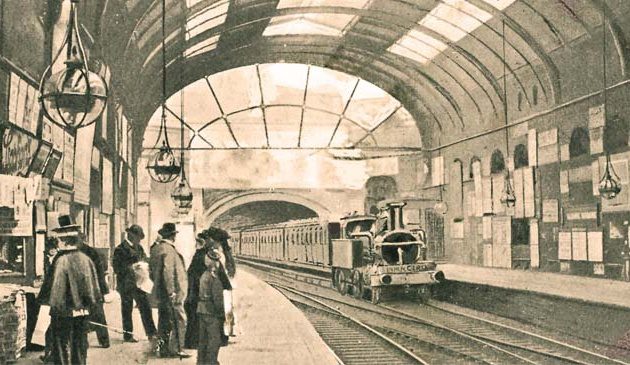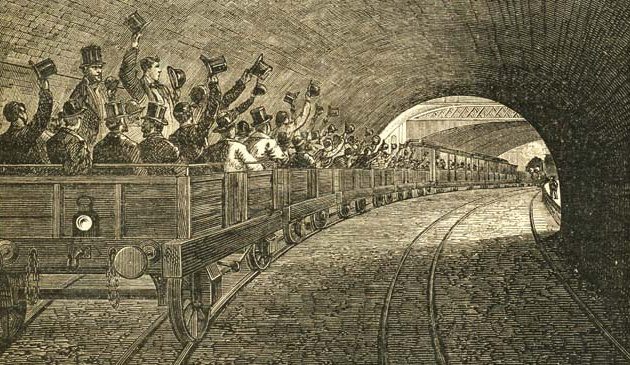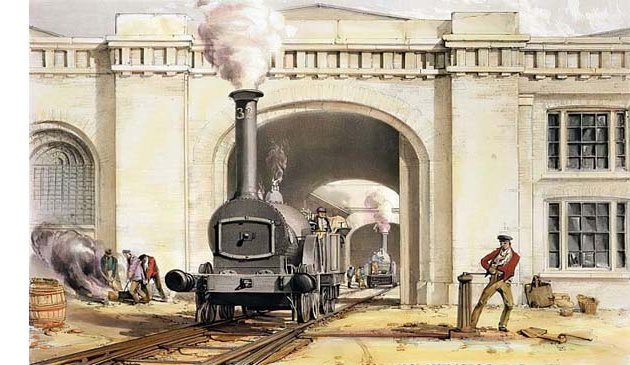The London & Blackwall Railway – one of the capital’s strangest railways

Minories station in about 1840. Passengers board one of the two trains on the line. In the foreground of this illustration the large circular drums can be seen around which the rope that pulls each train is wound.
The London & Blackwall Railway was one of the earliest lines in London. It was the first to enter the City of London, creating its terminus at Fenchurch Street and – literally – laid the foundations for today’s Dockland Light Railway. It worked using an extraordinary method by today’s standards, with trains hauled by cable instead of steam locomotives for the first nine years. It was also a hybrid business, operating both train and boat services.
During the 1830s steamboat services, both for pleasure and commuting, proliferated along the Thames. Popular downriver destinations were Gravesend and the nearby Rosherville pleasure gardens, as well as Southend, and Thanet. Many of those services made a stop at the East India Dock Company’s Brunswick Quay at Blackwall. The 6½ mile boat trip around the Isle of Dogs from Blackwall to London Bridge took about an hour, whereas a four-mile overland train journey into the City could be made in just 15 minutes. Additionally, several thousand workers commuted from their homes in East London to the docks each day and could more speedily reach their place of employment by railway.
John Rennie (the Younger) had seen the potential and proposed such a railway, with a route running from near Fenchurch Street, parallel with Commercial Road, and terminating at Blackwall. The Commercial Railway Company was formed with this route in mind. A competing group, the London & Blackwall and Steam Navigation Depot Company, then proposed an alternative, more northerly, route via Whitechapel High Street. In 1835 George Stephenson was asked to compare the two schemes and agreed that Rennie’s southern route was the most suitable. At the suggestion of a Parliamentary Committee the two groups joined forces in 1836. William Tite, the surveyor of the Commercial Railway, was employed as architect and surveyor. In January 1838 George Stephenson and George Parker Bidder were appointed as joint engineers.
The Act to create the line from Blackwall to the Minories, just on the edge of the City, was passed in 1837. The company subsequently changed its name to the London & Blackwall Railway Company.
Part of Brunswick Quay was purchased by the company and renamed Blackwall Pier. An elegant two-storey terminus building, designed by Tite, was constructed in Italianesque style. It faced the river and included railway and customs offices. Blackwall Pier had the distinction of having the first station bookshop, something which was copied on station platforms around the country.
It had been the company’s intension for the City terminus to be close to Fenchurch Street but there were strong objections from the City of London Corporation. A temporary station was therefore created at the Minories, now the site of the Docklands Light Railway Tower Gateway station. For the convenience of dockers there were intermediate stations at half mile intervals along the line at Shadwell, Stepney, Limehouse, West India Docks, and Poplar.
The line was the first to pass entirely through a densely built-up part of London. It had to cross many streets and the Regent’s Canal so, like the London & Greenwich and Eastern Counties railways, was built on a brick viaduct of arches as far as the West India Docks. Even so, trains would pass close to the windows of upper floors of buildings. There was the danger that hot cinders from the chimneys of steam locomotives would cause fires, especially to the various ropeworks along the route and barges in the Regent’s Canal Dock. George Stephenson and Bidder therefore recommended the use of rope haulage in place of steam locomotives. Each train would be hauled by a hemp rope of 5¾ inches diameter, powered by stationary engines at the Blackwall and the Minories ends of the line. The ropes reached to 350 yards before the end of the line at Blackwall. A slight gradient from there to Blackwall Pier allowed time for carriages to come to a halt, or to provide gravity assistance when departing. A speed of 30 miles per hour was possible along the route. It was not the first railway in London to use such a system. Robert Stephenson had devised such a method to haul trains on the London & Birmingham Railway for the first 1½ miles up the steep incline from the terminus at Euston as far as Camden before continuing their journey to Birmingham by steam locomotive. That continued at Euston until by 1844 more powerful locomotives were introduced.
The London & Blackwall initially used an unusual rail gauge of five feet. There were two trains, each of which always kept to one of the two tracks along the line. Both trains always left from opposite ends of the line at the same time, with 15-minutes between each service. Once each was in motion it would continue non-stop until reaching the far end of the line. Every coach had its own conductor on board. As the train reached a stop the conductor of the last carriage uncoupled it from the one in front and applied a brake, leaving it in the station. The process continued at each stop. When the direction was reversed for the return journey each carriage was separately hooked to the rope, arriving back individually and at different times to the terminus. Travel between individual stations was only possible by first going to one of the termini. Staff at each station could communicate using the recently invented Cook & Wheatstone telegraph system.
The first class carriages held up to 30 passengers, each sitting five aside within three compartments, while other travellers stood in the open coaches. The line gained the nickname ‘four-penny rope’ due to the cost of a ticket in the latter.


